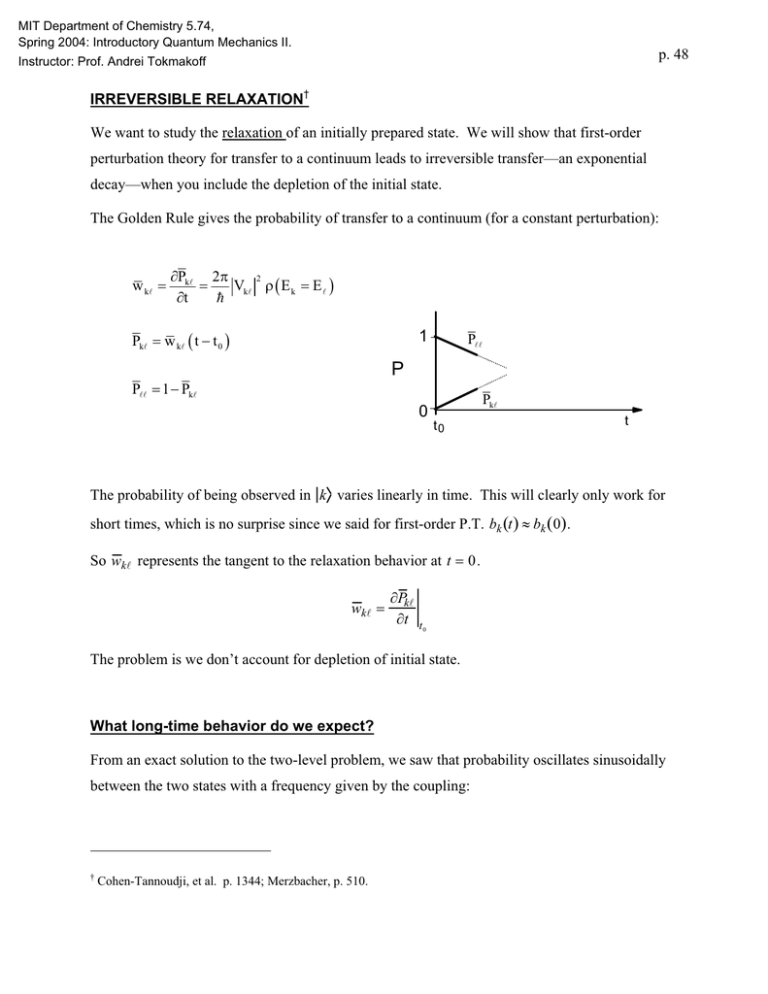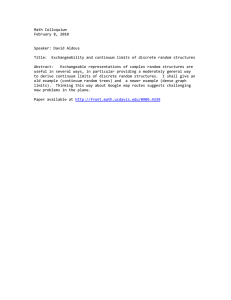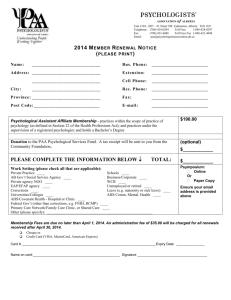Document 13492582
advertisement

MIT Department of Chemistry 5.74,
Spring 2004: Introductory Quantum Mechanics II.
p. 48
Instructor: Prof. Andrei Tokmakoff
IRREVERSIBLE RELAXATION†
We want to study the relaxation of an initially prepared state. We will show that first-order
perturbation theory for transfer to a continuum leads to irreversible transfer—an exponential
decay—when you include the depletion of the initial state.
The Golden Rule gives the probability of transfer to a continuum (for a constant perturbation):
w kA
PkA
wPkA
wt
2S
2
VkA U E k
=
EA 1
w kA t t 0 PAA
P
PAA
1 PkA
0
PkA
t
t0
The probability of being observed in k varies linearly in time. This will clearly only work for
short times, which is no surprise since we said for first-order P.T. bk t | bk 0.
So wkA represents the tangent to the relaxation behavior at t
wkA
wPkA
wt
0.
t0
The problem is we don’t account for depletion of initial state.
What long-time behavior do we expect?
From an exact solution to the two-level problem, we saw that probability oscillates sinusoidally
between the two states with a frequency given by the coupling:
†
Cohen-Tannoudji, et al. p. 1344; Merzbacher, p. 510.
p. 49
1st order P.T.
1
PAA
P
PkA
0
0
t
S / :R
:R
'2 VkA2
=
But we don’t have a two-state system. Rather, we are relaxing to a continuum.
wkA . Statistically, for relaxation from
Fermi’s Golden Rule says we have a time-independent rate, an initial state, including depletion of the initial state, a constant rate implies exponential decay:
PAA t dt wPAA
wt
PAA t >1 w kA dt @
PAA t dt PAA t dt
PAA t w kA
PAA t exp > w kA t @
PAA 0 1
You get exponential decay with some big assumptions:
Irreversible decay: the system never returns to its initial state—no feedback as in two-level system
History independent of initial state: whether or not the initial state is occupied does not influence
future development
COUPLING TO CONTINUUM
When we look at the long-time probability amplitude of the initial state (including depletion and
feedback), we will find that we get exponential decay. The decay of the initial state is irreversible
because there is feedback with a distribution of destructively interfering phases.
Let’s look at transitions to a continuum of states ^k
perturbation.
` from an initial state A —under constant
p. 50
1
¦n
A A ¦k k
n
n
k
continuum
initial
We want a more accurate description of:
k UI t,t0 A
b t k
The exact solution to U I was:
t
U I t, t 0 1 =i ³ dW VI W U I W, t 0 t0
For first-order P.T., we set this to 1. Here we keep as is…
t
bk t k A =i ³ dW k VI W U I W, t 0 A
t0
n insert
¦n
n
n
G kA i
=
¦³
t
t0
n
dW eiZkn W Vkn b n W Here Vkn is not a function of time
or in its differential form:
i=
wb k
wt
¦e
iZkn t
Vkn b n t (1)
n
These exact forms allow for feedback. This is the general form, where the amplitudes bk depend
on all other states.
For transitions into the continuum, let’s assume that transitions in the continuum only occur from
initial state:
k V kc
0.
So we can remove summation, and express the complex amplitude of a continuum state as
bk
t
=i VkA ³ dW e iZ kAW bA W t0
(2)
We want to calculate the rate of leaving A , including feeding from continuum back into initial
state. From (1):
p. 51
w
i= bA
wt
¦ eiZ
Ak
t
VAk bk VAA bA
(3)
kzA
feedback into A
sum over continuum
Substitute (2) into (3), and setting t0
w bA
wt
1
=2
t
2
0:
¦ V ³ b W e
kA
k zA
iZkA W t A
0
dW =i VAA bA t bA depends on entire history of
This is an integro-differential equation: the time-development of the system. Note we have two time variables:
W:
A o k
t:
k o A
bA varies slowly relative to ZkA , so we can remove it from integral.
Assumption: wbA
wt
ª
b A « =12 ¦ VkA
¬
k zA
2
t
³e
iZkA W t 0
º
dW =i VAA »
¼
Now, we want the long time behavior: t !!
1
, so we want to investigate the limit t o f .
ZkA
Focus on integral. Defining t c W t dt c dW
t
³e
iZkA W t 0
Note on integral:
dW
lim
Tof
f
t
³e
iZkA t c
0
³
T
0
dt c
e iZtcdtc
eiZ tc dt c
Instead integrate
³
lim
o 0
Z
i 2 2
2
Z
Z
1
iZ
0
(purely oscillatory / not well behaved)
2
Cauchy Principle Part: 1x
take o 0
SG Z i
­ 1x x z 0
®
¯0 x 0
1
Z
p. 52
ª
º
2
«
VkA · »»
i §
S
2
«
b A 2 ¦ VkA G ZkA ¨ VAA ¦
¸
¸
« = k zA
= ¨©
k zA E k EA »
¹»
«
term1
term 2
¬«
¼»
wb A
wt
Term 1 is just the Golden Rule rate! Here we have replaced the sum over continuum states by a
integral
¦
G Z kA kzA
=
U Ek
EA w kA
ª 2S
³ dE U E «¬ =
k
k
2
º
VkA G E k E A »
¼
Term 2 is just the correction of the energy of EA from second-order time-independent perturbation
theory, 'E A .
'E A
A V A ¦
k zA
k VA
2
Ek EA
So, we have
wbA
wt
§ w
·
b A ¨ kA =i 'E A ¸
© 2
¹
bA 0 1 ,
with § w t
·
b A t exp ¨ kA =i 'E A t ¸
2
©
¹
Exponential decay! Irreversible relaxation from coupling to the continuum.
Switching back to Schrödinger Picture, cA
bAe iZ A t
ª §w
§ E 'E A · · º
cA t exp « ¨ kA i ¨ A
¸¸ t»
=
©
¹¹ ¼
¬ © 2
p. 53
We expect solutions to the T.D.S.E. to be complex and oscillatory:
c
A
PA
> @
exp i:̃t
cA
2
º
Im ª¬:
¼
w kA
2
dissipative
º
Re ª¬:
¼
EcA
=
dispersive
EcA { E A 'E
exp > w kA t @
1
Probability decays exponentially from initial state.
PA
Fermi’s Golden Rule rate tells you about long times!
0
t0
t
1/ w kA
1st order P.T.
What is the probability of appearing in k ? Using eqn. 2:
t
b k t =i ³ VkA eiZkA W b A W dW
0
bk t § w
·
1 exp ¨ kA t =i EcA E k t ¸
© 2
¹
VkA
E k EcA i=w kA / 2
VkA
1 cA (t)
E k EcA i=w kA / 2
Final state resonant with
shifted initial states.
For long times t o f PkA
VkA
E k EcA 2
2
*2 / 4
Pk
*
* { w kA =
E A 'E
Ek





